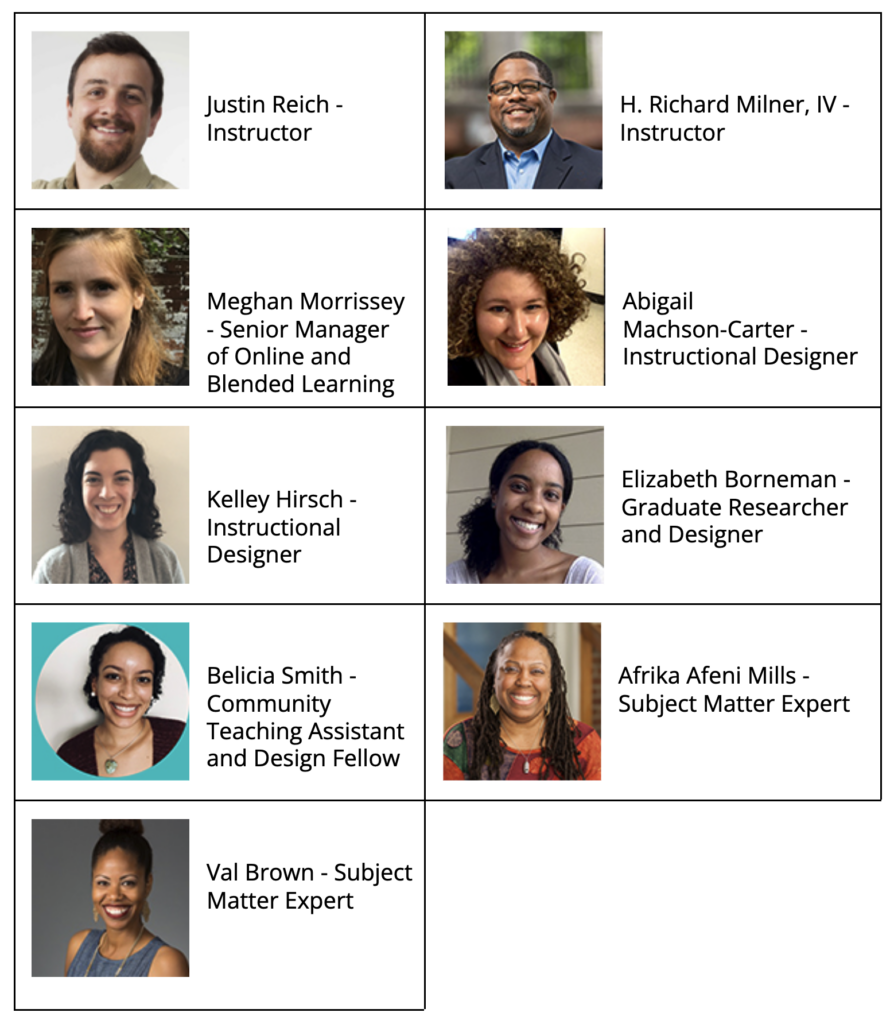Taking the Course with Colleagues
We believe the best way to take this course is with other colleagues from your community who understand your context, the students in your school, and the culture of your organization. While you’re welcome to take the course by yourself, we encourage you to participate in this learning experience with other members of your school or organization if possible.
If you are taking the course with others in your context, we encourage you to collaborate. For example, a group of educators from the same school might choose to work together on the activities and assignments, and we think that’s terrific.
Recruiting some peers to take the course with you will give you an especially powerful learning experience. However, we recognize that not every participant will be taking this with a group of colleagues. In that case, we still encourage you to bring your assignments into your school, however informally. For example, discuss assignments with colleagues, share videos with peers, or talk with a student about ideas from the course. This course is about taking action, and the action step of each assignment can be taken whether or not you’re formally taking the course with others.
Form a Learning Circle
One way to work together with a group of colleagues who are interested in the course is to form a learning circle.
What is a learning circle?
A learning circle is an in-person discussion group for learners who are all taking Becoming a More Equitable Educator.
Why form a learning circle?
This course is designed to encourage you to use what you learn in your context as soon as possible. Your learning circle can provide encouragement, support, and diverse perspectives.
How will my peers benefit from joining a learning circle?
No one knows your school or context better than the people who work there every day, and asking your colleagues to join you in taking this course is a step toward building a cohort of colleagues committed to equitable practices. We encourage you to be bold and reach out (feel free to use the email and social media templates in the facilitator’s guide). You might be surprised who responds!
What materials can help us create powerful learning circles?
We’ve created the Learning Circle Guide for Becoming a More Equitable Educator to give you the tools you need to form a learning circle. In this guide are suggested discussion topics and activities for meetings, but we encourage your learning circle to interact with the course in the ways that seem most valuable and productive for your needs. The way in which your learning circle engages with the course is entirely up to you.
For each unit in the course, we’ll provide:
- Discussion questions for select videos and readings
- Activities or practices spaces to talk about together
- Ways to collaborate or give feedback on course assignments
Access the Learning Circle Guide as a Google Doc or a PDF.
Social Media
Social media have created powerful new tools for educators to form informal communities of practice with others around the world. As you proceed through the course, we encourage you to share your learning both in our forums and in whatever online networks you participate in. This is optional and you are not required to join or use these tools. One advantage of participating in these networks is that they allow you to make connections that can persist beyond the end of this course. They also allow you to share your learning in this course with your local community and other networks.
As always, whenever you share on social media, be thoughtful about how your posts will be received by colleagues and community, and be sure to follow local norms, rules, and guidelines.
Follow the Teaching Systems Lab on Twitter
Those of you who are active on Twitter can follow us @MoocsTsl and share what you are learning in this course with the #TSLequity hashtag.
Explore More Equity Conversations on Twitter
There are also several active communities of educators discussing equity on Twitter that we encourage you check out including: Clear the Air (@ClearTheAirEdu and #ClearTheAir), Disrupt Texts (#DisruptTexts), and Edu Color (@EduColor and #EduColor).
Our Team

Additional Credits
Video Producers: Garrett Beazley & FreshCognate (Aimee Corrigan, Denez McAdoo, Daymian Mejia, Doug Pietrzak)
Engineer for the Forums: Kate Wilson
Graphic Design by Studio Malagón
Key Team Members at MITx: Sarah Davis & Shelly Upton
Additional Acknowledgements: Thanks to the people and schools who graciously let us come into their lives and film. Thanks to Jessica Ball for your input and feedback. Thanks to Lisa Graustein and Kelly Wickham Hurst for sharing your insights with us. Thanks to the Equity Fellows, Lizzie Fortin, Johanna Spears, Daniela Escobar, and Erin Kelley, our bold field testers, who helped us try out some of this material in their own schools.
